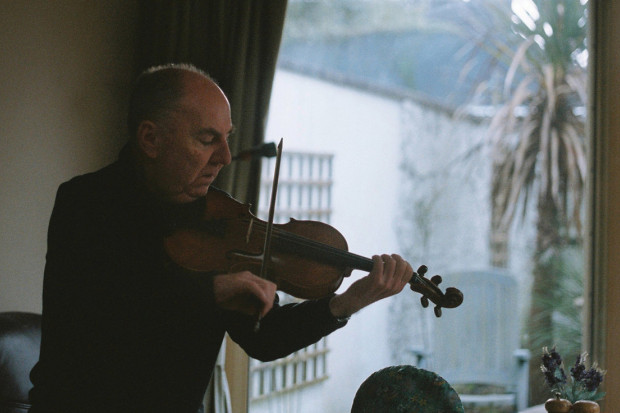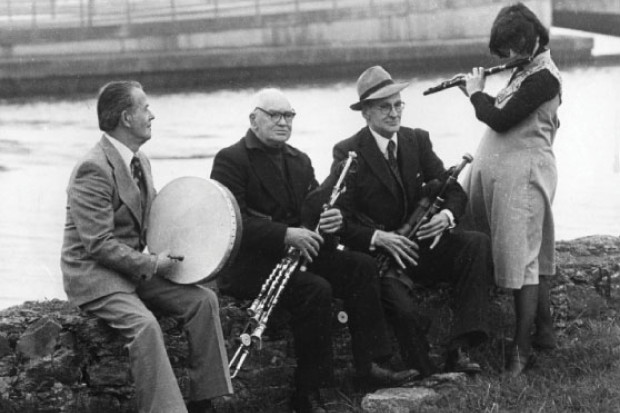
Micho Russell (1915–94). Photo by Jim Maginn from the book ‘The Light of Other Days’. www.jimmaginn.com
The Star of the Folk Revival
Micho Russell was born to native Irish speakers Austin and Annie Russell in 1915, one of three musician brothers and all bachelor farmers. He lived his entire life in Doolin, Co. Clare, the contemporary mecca of traditional music (a status that Russell is, at least in part, responsible for), apart from his professional touring life as a musician which only began in his mid-fifties. This recently issued two-CD collection, Rarities and Old Favourites 1949–1993: Tin Whistle, Flute & Songs from North Clare and Beyond, is not a collection of all that Russell recorded, but it is comprehensive and distinctive in that it features performances from the contexts he would have been heard in over his long life, many of which are previously unpublished.
There are tracks from the more ‘natural’ contexts for traditional music (the home, the session); others from more formal concerts (particularly in the United States); and studio recordings. This enlightening collection has been carefully constructed by American producer Bill Ochs who had previously released Ireland’s Whistling Ambassador in 1995 – the year following Russell’s death. Ochs has very obviously uncovered a peerless collection of Russell’s music and perhaps the greatest strength of this collection is its sheer diversity, giving us insight into the many faces of Russell’s musicianship.
Black and white
As a young flute player in the early nineties I had the privilege to see Micho Russell perform a lunchtime concert in University College Cork and, later that evening, in the now legendary Lobby Bar on Union Quay. My world at the time, both musical and academic, was very black and white, and my own personal journey in many ways was one that looked for complexity as an end in itself. Thus the music of Russell wasn’t one I expected to like or appreciate.
I found myself being dragged along because I should – his music was supposed to be important, or, perhaps more accurately, the tradition he embodied and sounded was important. However, what initially impressed me was his personality and the sheer strength and engagement of his performance. Russell was a wonderful performer, able to creatively gauge his engagement with his particular audience. He created a stage persona, dressed with flat cap and braces, speaking with his iconic West Clare drawl, and designed the presentation and performance of his songs, tunes and stories to suit his two different audiences that day. He managed this in ways that were essentially honest and spoke of him and his place and tradition while creating two very different events. It is this engagement aspect of performance that is hardest to get over through CD recordings. The CD can never put the listener into the performance (thank God!). However, this publication does include vocal introductions and comical songs from Russell and isn’t bothered by studio values around extraneous sound, technical perfection and audience noises. Thus we are given as good an idea as is possible of Russell the performer and the raconteur, enough to show us what has been lost in his passing twenty-one years ago.
Russell’s palette of technique
For me that day in Cork was the start of an appreciation of Micho Russell, an appreciation that started with the performer and moved on to the musician. Russell is certainly not the virtuoso musician of the kind that is often valorised today. Technically he is not a Mary Bergin, Sean Ryan or Brian Finnegan. But that is not the point – he was a musician who could make profound music and create a musical personality out of a limited palette of technique.
Ornamentally, Russell used cuts, triplets and rolls and little else – but he is using them out of a singular, sparse aesthetic which plays down the rhythmical nature of ornamental practice and is perhaps closer to the song tradition. In ‘Tom Baun’s Reel’ (CD 2, track 8) he doesn’t play a single ornament until the second part of the tune and, in all, plays only three long rolls in the whole three rounds of the tune, something perhaps unthinkable in contemporary whistle playing. His phrasing is generally extremely square – when he plays ‘When Sick Old Hag is it Tea You Want?’ or ‘The Butchers March’ (CD 1, Track 9) every phrase break is at the end of two or four bars, following faithfully (if occasionally hiding) the natural phrasing of the tune. When he does stop at the end of the phrase, he very often accentuates the break, playing the first note of the beat but losing the rest. Again this often gives his performance a lyrical, song-like quality.
I find there is a really playful quality in the way that Russell uses articulation (the breaks made between notes, in this case most likely through the use of the tongue or maybe glottal stops), again often to hide the rhythmical impetus. It would be impossible to work out what types of articulation Russell employs where, but you can certainly hear on the jig ‘The Battle of Fontenoy’ (CD 1, track 2) some of the ways he uses articulation, from the most understated to the most staccato to create rhythm, drama and fun.
Like his contemporary further down the Clare coast at the Crosses of Annagh and later removed to London, fiddle-player Bobby Casey, Russell often slurs over the main beats and articulates off these beats to create subtle and complex rhythmical tensions. Another trademark feature of his playing was that he liked to play long notes, especially at the end of phrases, not filling time with ornaments but with a slight swelling in dynamic. Good examples of this can be heard in the second of two quadrilles, ‘The Cumann na mBan is Dead and Gone’ (CD 2, track 19).
Complexity on its own terms
To say that Micho has a simple or uncomplicated style would not do him justice: he had an idiosyncratic style with a complexity built on its own terms. This style was undoubtedly rooted in his own vocal style and the north Clare concertina music he would have grown up with, listening to his mother and brother.
These aspects of his playing on whistle, flute and piccolo are all heard in abundance on this recording (although the single track of piccolo recorded by Séamus Ennis in 1948 does sound a lot like a whistle to me – we can only take Séamus’ word for it!). Bill Ochs has tried to give us some of the rarer, more peculiar repertoire associated with Doolin and West Clare and I for one think I will only play Russell’s version of the ‘High Level’ hornpipe from now on in an attempt to confuse all around me. It is also wonderful to hear the rounder and softer tone that has all but disappeared from contemporary flute playing. The six songs top off the collection and perhaps illustrate the central place of song in the aesthetic of Micho Russell as well as the fact that he never took himself too seriously. The broad timeframe of these recordings gives us a picture of a musician maturing away from the demands of the dance and relaxing more into the demands of the listener, the way of the song.
As I write this I am looking at the broken remains of the CD box and am a little annoyed that a track on the first CD is now skipping. This is as a result of having this CD on in the car, in the office and in my home for the past month and the fact that I am a fan. But this is not a ‘Best of’ compilation of pre-published materials that fans often avoid, but a carefully selected and reproduced collection of material by a producer intimate with this music and milieu. It gives us a real insight into the life and music of the bachelor farmer and folk revival star – Micho Russell.
–
Rarities and Old Favourites 1949-1993: Tin Whistle, Flute and Songs from North Clare and Beyond by Micho Russell is available from The Pennywhistler’s Press.
Published on 4 November 2015
Niall Keegan is a traditional flute player and Associate Director at the Irish World Academy of Music and Dance, University of Limerick.















